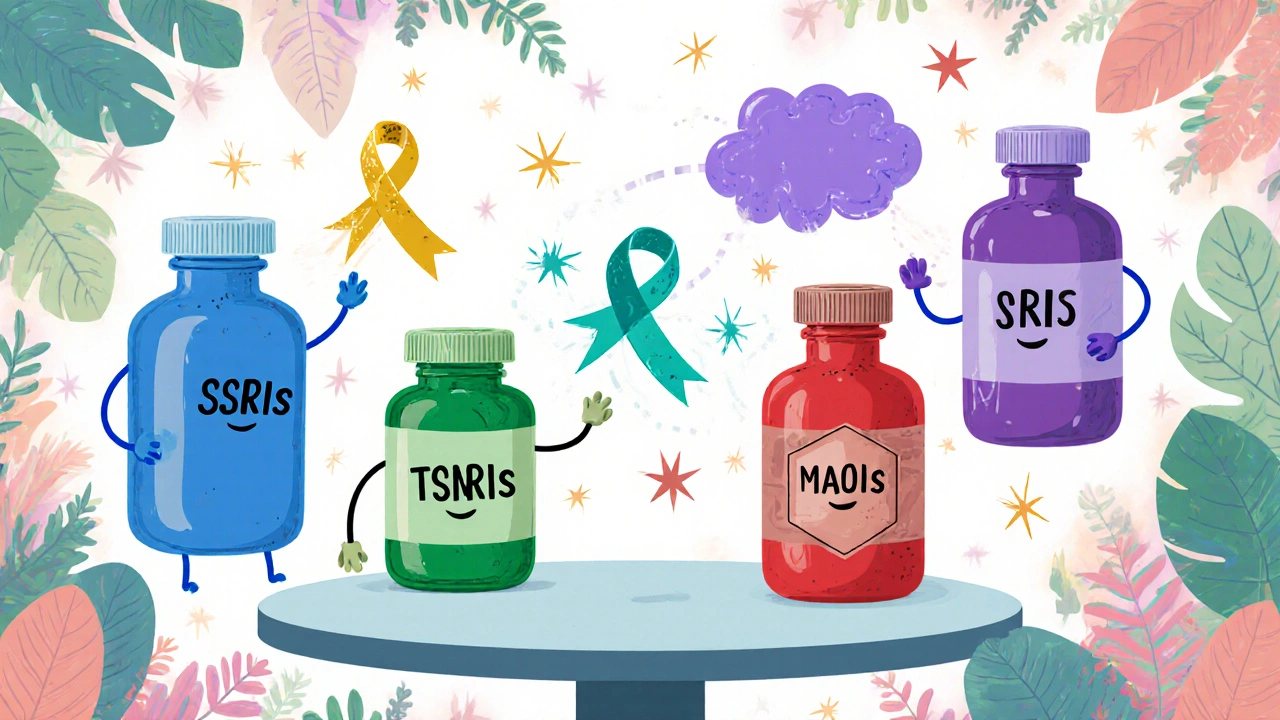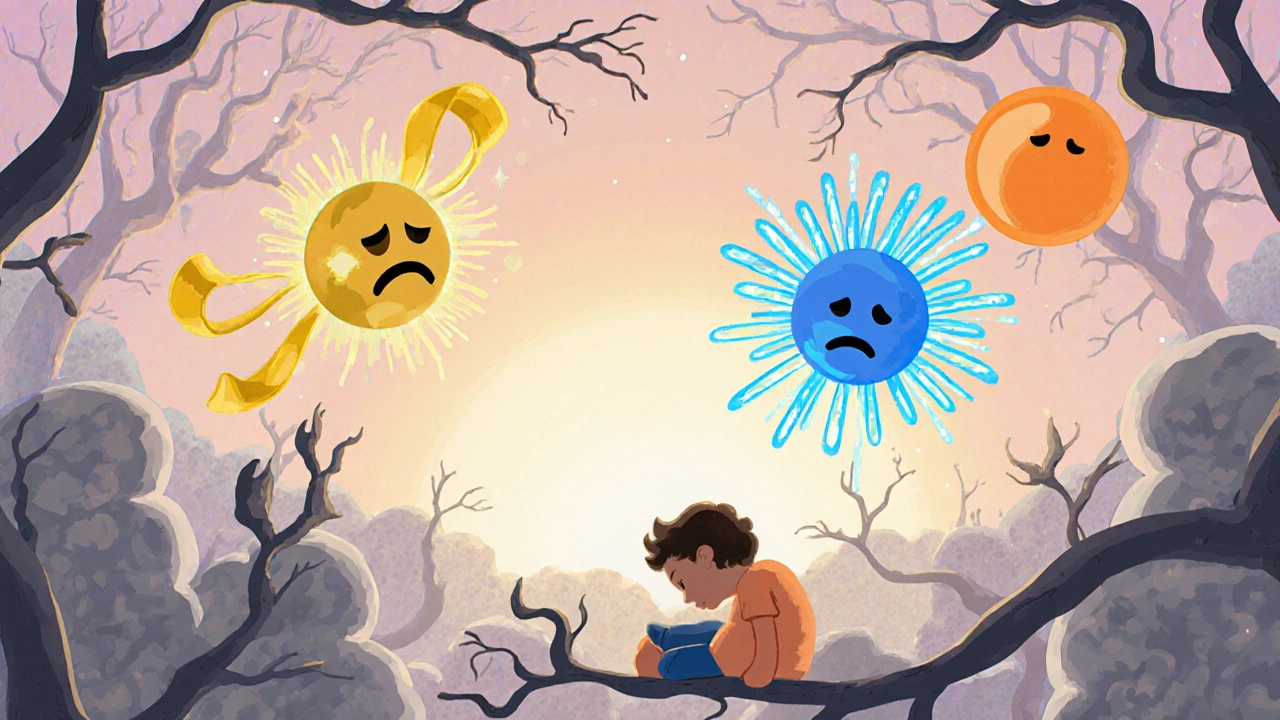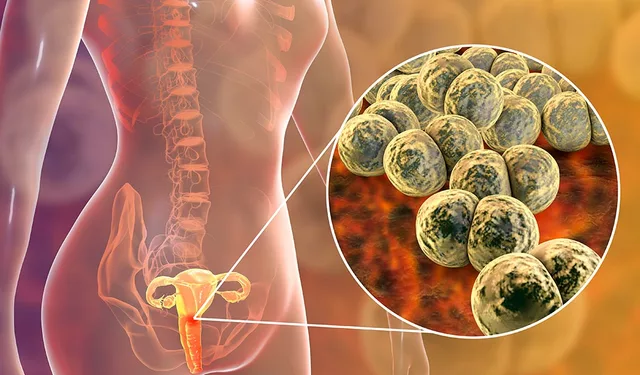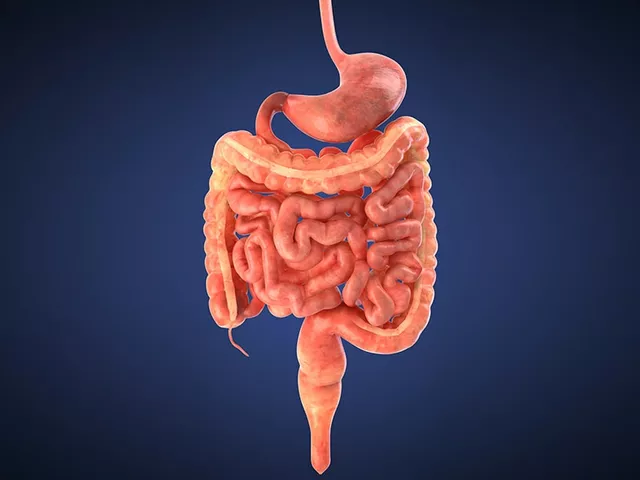Antidepressant Symptom Matchmaker
Find Your Best Match
Select your primary symptoms to see which antidepressant classes may be most appropriate for your situation.
Note: This tool is for informational purposes only and should not replace professional medical advice.
When you hear the term Antidepressant medications are drugs designed to relieve symptoms of depression by altering brain chemistry, you probably wonder what actually happens inside your head.
Why we need medication for depression
Depression isn't just feeling sad; it’s a complex brain‑body syndrome that can shut down motivation, concentration, and even basic self‑care. Research shows that people with major depressive disorder often have imbalances in Neurotransmitters chemical messengers that transmit signals between neurons. Those imbalances don’t fix themselves in many cases, so clinicians turn to medication to correct the wiring.
How antidepressants change brain chemistry
All antidepressants share a core idea: boost the activity of neurotransmitters that promote mood. The most common targets are serotonin, norepinephrine, and dopamine. Below is a quick snapshot of the four major classes and the neurotransmitters they affect.
| Class | Primary neurotransmitters | Typical onset (weeks) | Common examples |
|---|---|---|---|
| SSRIs | Serotonin | 2-4 | Fluoxetine, sertraline |
| SNRIs | Serotonin & norepinephrine | 2-4 | Venlafaxine, duloxetine |
| TCAs | Serotonin, norepinephrine, histamine | 3-6 | Amitriptyline, nortriptyline |
| MAOIs | Serotonin, norepinephrine, dopamine | 3-6 | Phenelzine, tranylcypromine |
Each class manipulates the brain in a slightly different way, which is why doctors match a patient’s symptom profile to the right chemistry.
SSRIs - the first‑line heroes
Selective serotonin reuptake inhibitors (SSRIs) block the re‑absorption of serotonin, leaving more of the chemical available in the synaptic gap are the most prescribed antidepressants worldwide. By preventing serotonin from being pulled back into the presynaptic neuron, SSRIs gently lift mood without the heavy sedation that older drugs caused.
Typical starting doses are low (e.g., 20mg of fluoxetine) and are titrated upward based on response and tolerability. Because they act on a single neurotransmitter system, side effects are usually milder than with broader‑acting agents.
SNRIs - a two‑for‑one approach
Serotonin-norepinephrine reuptake inhibitors (SNRIs) inhibit the re‑uptake of both serotonin and norepinephrine, giving a dual‑boost to mood and energy. Patients who feel lethargic or have chronic pain often benefit because norepinephrine also modulates the pain pathways.
Common SNRIs like venlafaxine can start at 37.5mg per day. A notable feature is a dose‑dependent shift: low doses act more like an SSRI, while higher doses begin to affect norepinephrine more strongly.

TCAs - the old‑school workhorses
Tricyclic antidepressants (TCAs) block the re‑uptake of serotonin and norepinephrine and also bind to histamine, muscarinic, and alpha‑adrenergic receptors. Their broad receptor activity explains both their efficacy and their baggage of side effects.
Side effects include dry mouth, constipation, blurry vision, and orthostatic hypotension. Because TCAs can affect heart rhythm, doctors usually reserve them for patients who haven’t responded to newer agents.
MAOIs - the niche specialists
Monoamine oxidase inhibitors (MAOIs) inhibit the enzyme monoamine oxidase, which breaks down serotonin, norepinephrine, and dopamine. By stopping that breakdown, MAOIs raise levels of all three neurotransmitters.
They require strict dietary restrictions (avoid tyramine‑rich foods like aged cheese) because excess norepinephrine can cause hypertensive crises. Because of that, MAOIs are typically a last‑line option.
How side effects arise
Side effects are not random; they mirror the same receptors the drug touches. For example, SSRIs increase serotonin not only in mood circuits but also in the gastrointestinal tract, which explains nausea and diarrhea for many users.
TCAs bind to histamine receptors, leading to sedation and weight gain. MAOIs affect blood pressure regulation, making the famous “cheese reaction” possible.
Understanding the pharmacology helps you anticipate what to monitor. Below is a quick cheat‑sheet of the most common adverse events per class.
- SSRIs: nausea, sexual dysfunction, insomnia, headache.
- SNRIs: similar to SSRIs plus increased blood pressure at high doses.
- TCAs: dry mouth, constipation, blurred vision, cardiac arrhythmia.
- MAOIs: hypertensive crisis with tyramine, orthostatic hypotension, insomnia.
Beyond side effects - withdrawal and drug interactions
Stopping an antidepressant abruptly can trigger a withdrawal syndrome a set of physical and psychological symptoms that appear when a medication is discontinued too quickly. Symptoms range from electric‑shock sensations (often called “brain zaps”) to anxiety and flu‑like malaise.
Gradual tapering, usually over several weeks, reduces the risk. Some clinicians use a switch‑to‑a longer‑acting agent like fluoxetine before tapering.
Drug-drug interactions are another hidden danger. Many antidepressants are metabolized by the liver enzyme CYP2D6. If you’re taking a medication that blocks CYP2D6 (e.g., certain antipsychotics), blood levels of the antidepressant can rise, increasing side‑effect risk.
Real‑world considerations for patients
Choosing a medication isn’t just a chemistry problem; it’s a lifestyle decision. Ask yourself:
- Do I need an energizing effect (SNRIs, TCAs) or a calming one (SSRIs, some TCAs)?
- Will my job or hobbies make the dietary restrictions of MAOIs impractical?
- Do I have a history of heart problems that might rule out TCAs?
- Am I pregnant, breastfeeding, or planning a pregnancy? Some drugs have safer profiles.
Open communication with your prescriber is key. Bring up all over‑the‑counter meds, supplements, and even herbal products like St.John’s wort, which can trigger dangerous interactions.
When medication isn’t enough
Medications work best when paired with psychotherapy, exercise, and good sleep hygiene. Cognitive‑behavioral therapy (CBT), for instance, can reduce the dosage needed for many patients, minimizing side effects.
In some cases, patients experience a ‘placebo effect’ where belief in treatment contributes to improvement. That’s why a supportive therapeutic relationship matters just as much as the pill itself.
Key takeaways
- Antidepressants target serotonin, norepinephrine, and/or dopamine to correct chemical imbalances.
- SSRIs are first‑line because they’re effective and have the mildest side‑effect profile.
- Broader‑acting agents (TCAs, MAOIs) are reserved for treatment‑resistant cases.
- Side effects mirror each drug’s receptor activity; knowing them helps you manage expectations.
- Never stop a medication abruptly; taper under medical supervision.
- Combine meds with therapy, lifestyle changes, and regular monitoring for the best outcomes.
Frequently Asked Questions
How long does it take for an antidepressant to start working?
Most people notice a subtle mood lift after 2-4 weeks, but full therapeutic effects can take up to 8 weeks. Patience and regular check‑ins with your clinician are essential.
Are antidepressants addictive?
They are not addictive in the classic sense-there’s no craving or compulsion. However, stopping suddenly can cause withdrawal, so tapering is recommended.
Can I take an antidepressant while pregnant?
Some SSRIs (like fluoxetine) have a relatively safe track record, but each case is unique. Always discuss risks and benefits with your obstetrician and psychiatrist.
Why do SSRIs cause sexual side effects?
Serotonin also regulates sexual arousal pathways. When serotonin levels stay high, libido, orgasm, and erectile function can diminish for many users.
What’s the difference between a TCA and an SSRI?
TCAs hit multiple receptors (serotonin, norepinephrine, histamine, muscarinic), causing more side effects but also a stronger effect for some people. SSRIs focus narrowly on serotonin, making them easier to tolerate.





Darlene Young
Great overview! The way you broke down each class makes it easy to see why a doctor might pick one over another. I especially liked the table that shows onset times-those numbers can be a lifesaver when setting patient expectations. It’s also useful to remember that “first‑line” doesn’t mean “one‑size‑fits‑all”; personal history matters a lot. Keep the science coming, it’s super helpful for folks navigating this maze.
Steve Kazandjian
Sounds solid, thanks for the clear rundown.
Roger Münger
The article correctly emphasizes the serotonergic mechanism of SSRIs, yet it could benefit from noting that not all patients experience a linear dose‑response curve. Pharmacokinetic variability, particularly involving CYP2D6 polymorphisms, can alter plasma concentrations dramatically. Additionally, the discussion of SNRIs might mention their impact on norepinephrine reuptake at higher dosages, which is clinically relevant for pain syndromes. While the side‑effect profile is accurate, one should also consider the potential for QT prolongation with certain TCAs. Finally, the brief mention of MAOIs should include the need for a washout period when switching from other antidepressants. Overall, the guide is thorough but could integrate these nuances for completeness.
Gerald Bangero
I hear you on the complexity-mental health truly sits at the crossroads of biology and lived experience. It’s encouraging to see a balanced take that doesn’t demonize medication. Remember, a pill can be a tool, not a crutch, especially when paired with therapy. Even if side effects appear daunting, many folks find that the benefits outweigh the drawbacks. Keep exploring, and stay hopeful about the journey toward well‑being.
John Nix
Esteemed author, your exposition on antidepressant pharmacodynamics is commendably comprehensive. The delineation of receptor affinities across the four principal classes furnishes an invaluable reference for clinicians. Moreover, the inclusion of dietary considerations for MAOIs demonstrates a prudent awareness of patient safety. I would, however, recommend an expanded discussion regarding the metabolic pathways mediated by hepatic enzymes. Nonetheless, the manuscript serves as an exemplary synthesis of contemporary psychopharmacology.
xie teresa
Thank you for putting this information together; it really helps demystify a confusing topic. I appreciate the gentle reminder that stopping medication abruptly can be risky. It’s comforting to know that tapering plans exist and can be tailored to each person. Your balanced tone makes the science feel more approachable for those of us coping with anxiety about meds.
Kayla Rayburn
Nice job breaking down the basics-makes it less intimidating for newcomers. I like how you highlighted that lifestyle tweaks go hand‑in‑hand with meds. It’s also cool that you mentioned the “brain zaps” people sometimes fear; naming it reduces the stigma. Keep sharing these practical pieces, they’re gold for anyone navigating treatment.
Dina Mohamed
Firstly, I want to commend the author for delivering such a thorough, yet digestible, guide to antidepressants; the clarity of the table alone is a commendable feat, as it instantly equips readers with a comparative snapshot of onset times, neurotransmitter targets, and exemplar drugs. Secondly, the section on SSRIs wisely points out their relatively mild side‑effect burden, however, it could further explore the prevalence of sexual dysfunction, which remains a leading cause of non‑adherence. Moreover, when discussing SNRIs, the mention of dose‑dependent norepinephrine effects is crucial, especially for patients battling both mood and neuropathic pain, and yet, a brief note on the potential for hypertension at higher doses would enhance safety awareness. In addition, the historical context of TCAs, while nostalgic, should be balanced with modern concerns such as cardiotoxicity, which underscores why routine ECG monitoring is sometimes advised. Furthermore, the dietary restrictions linked to MAOIs are well‑articulated, but a quick reference chart of tyramine‑rich foods could spare readers from accidental hypertensive crises. Also, the explanation of withdrawal phenomena, colloquially termed “brain zaps,” is spot‑on, nonetheless, elaborating on the typical tapering schedule-such as switching to fluoxetine before tapering-would provide a practical roadmap. Consequently, the emphasis on combining pharmacotherapy with psychotherapy aligns with evidence‑based practices, yet citing specific CBT success rates could bolster the argument. Additionally, the brief nod to St. John’s wort is pertinent, but a warning about its potent cytochrome P450 induction would further protect patients from hazardous interactions. Likewise, the illustration of how serotonin receptors in the gastrointestinal tract mediate nausea is insightful, and it could be complemented by tips like taking medication with food to mitigate discomfort. Moreover, the caution regarding TCAs’ anticholinergic load is valuable, particularly for elderly patients prone to delirium, and a recommendation for alternative agents in that demographic would be beneficial. Furthermore, the guide rightly advises against abrupt discontinuation, yet it might also mention that some clinicians use a cross‑taper strategy when switching between classes. Additionally, acknowledging that genetic testing for CYP polymorphisms is becoming more accessible could empower patients to personalize their treatment plans. The inclusion of a simple graphic summarizing common adverse events per class would also aid visual learners in retaining the information. Overall, this guide stands as a valuable resource that bridges scientific detail with patient‑centered practicality.
Kitty Lorentz
this was helpful i learned a lot especially about the diet part it was clear. thanks for the info
Jenny Newell
The piece hits the main points, but the depth feels a bit surface‑level; more pharmacodynamics jargon would satisfy the clinician crowd. Overall, it’s a competent summary, albeit lacking deep mechanistic nuance. Still, it serves a decent lay audience.
Kevin Zac
I’d add that considering the enzyme CYP450 substrate profile can preempt many drug‑drug interactions; for instance, fluoxetine’s inhibition of CYP2D6 often raises plasma levels of co‑administered beta‑blockers. Also, using the term “therapeutic window” when discussing TCAs helps frame dosage safety. A brief note on the pharmacokinetic half‑life differences between fluoxetine and paroxetine could guide taper strategies. Incorporating these details would make the guide even more robust for both prescribers and patients. Thanks for the thorough overview.
Bianca Fernández Rodríguez
Honestly, the article downplays the risks of long‑term SSRI use; weight gain and emotional blunting can be as debilitating as depression itself. Also, the claim that MAOIs are only “last‑line” ignores their superior efficacy in atypical depression. Readers should stay skeptical and seek second opinions before committing to any regimen.